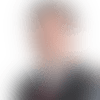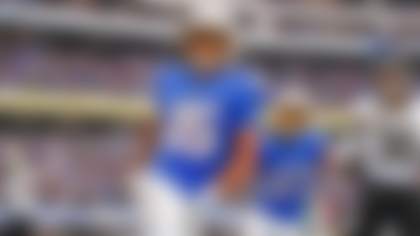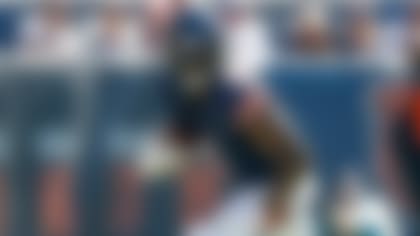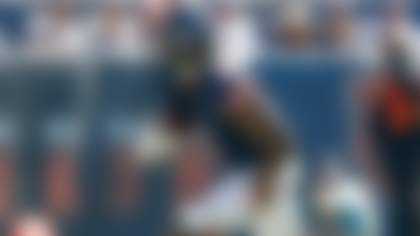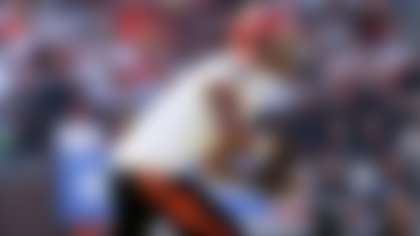Why provide instant grades on the selections of prospects who have yet to take an NFL snap? Well, you're reading this, aren't you? Considering the makeup of every roster and the factors surrounding each pick, Gennaro Filice and Dan Parr attempt a division-by-division assessment of the 2020 NFL Draft. Keep in mind that these grades are based on draft hauls alone -- picks traded for veteran players were not taken into account. Below is Gennaro's review of the NFC West.
NOTABLE SELECTIONS
BEST PICK: Josh Jones, OT, Houston
Arizona Cardinals, Round 3, No. 72 overall
If this category were MOST FUN PICK, Arizona's initial selection of Isaiah Simmons would get the shine. At No. 8 overall, GM Steve Keim boldly eschewed three highly regarded prospects at offensive tackle -- the team's most glaring need -- in favor of the one-of-a-kind hybrid defender out of Clemson. Unquestionably thrilling in the moment, that decision could have really blown up in the Cardinals' face, by allowing opposing defenses to continue blowing up Kyler Murray's pocket. But then the draft fell in the Cards' favor, with Jones remaining on the board over the next 63 picks, until Arizona finally came on the clock for its second pick of the draft. (Remember, the Cardinals traded their second-round pick in the DeAndre Hopkins heist.) After four years as Houston's starting left tackle and a dominant showing at the Senior Bowl, Jones had received first-round buzz through much of the pre-draft process. So what was he doing sitting there on Friday night, ripe for the picking in Round 3? Kliff Kingsbury wondered the same thing. During an appearance this week on Arizona Sports 98.7 FM, the Cardinals' second-year head coach re-enacted a reconnaissance call with the University of Houston coaching staff to figure out why Jones was sliding. "We're calling saying, 'What's going on? Did he kill somebody last night? Is there something we don't know about? What's the issue?' " Kingsbury said. "They were kind of scratching their heads as well." Keim eventually made the pick, landing the No. 14 overall player on Pro Football Focus' big board in the 72nd draft slot.
MOST SURPRISING PICK: Jordyn Brooks, LB, Texas Tech
Seattle Seahawks, Round 1, No. 27 overall
In the Pete Carroll/John Schneider era, Seattle typically does one of two things with its first-round pick: 1) trade it; or 2) use it on a player you didn't see coming. In the year 2020, the Seahawks went the latter route. The selection of Brooks was surprising on multiple levels. First of all, with Russell Wilson squarely in his prime at age 31, Seattle should be in win-now mode. Is Brooks a win-now pick? Linebacker didn't appear to be anywhere near the Seahawks' most pressing needs -- not with Bobby Wagner locked in on a record-setting deal, K.J Wright still under contract for another season and 2019 third-rounder Cody Bartonroutinely fielding praise from Carroll (well, when he's not playing catch with the head coach's poor nose). Did Seattle make a first-round luxury pick at a time when the roster's rife with questions in the trenches? And then there's Brooks' skill set. Extremely fast and physical, Brooks plays downhill as a classic run-and-chase linebacker, creating violent collisions and racking up tackles in bunches. That was a first-round formula in the NFL draft for decades ... but not in 2020. In today's pass-happy league, high-value 'backers boast bona fide coverage chops. At least from what Brooks showed at Texas Tech, that's just not the 27th overall pick's game. Nope, that's the calling card of Patrick Queen -- the linebacker Baltimore pounced on at No. 28.
BIGGEST SLEEPER: Terrell Burgess, S, Utah
Los Angeles Rams, Round 3, No. 104 overall
When it comes to playing safety in the modern NFL, versatility is king. And Burgess has it in spades. Just check out all of the places he lined up for the Utes in 2019, according to PFF:
Free safety: 133 snaps
Box: 285 snaps
Corner: 27 snaps
Slot corner: 272 snaps
Defensive line: 66 snaps
That's quite the spread. And it's the kind of positional flexibility that could allow the late third-rounder to make significant contributions in Year 1. In addition to spelling/supplementing starting safeties Taylor Rapp and John Johnson -- and perhaps offering more single-high ability than either -- Burgess could end up filling the vacancy at nickelback, with the Rams having declined Nickell Robey-Coleman's contract option back in March. One way or another, L.A. must find a way to tap into this instinctive defensive back's myriad talents.
TEAM GRADES
NOTE: Draft classes are ranked from best to worst within the division.
» Round 1: (No. 8 overall) Isaiah Simmons, LB/S, Clemson.
» Round 3: (72) Josh Jones, OT, Houston.
» Round 4: (114) Leki Fotu, DT, Utah; (131) Rashard Lawrence, DT, LSU.
» Round 6: (202) Evan Weaver, LB, Cal.
» Round 7: (222) Eno Benjamin, RB, Arizona State.
Three years ago, Steve Keim spent his first-round pick on hybrid defender Haason Reddick. When asked how the Temple product would fit into Arizona's defense, the Cardinals general manager gushed: "That's the beauty of it -- it doesn't matter," Keim said at the time. "We'll find a place for him. Whether it's early as a rusher or as a stack-backer, he has got enough skills to be a difference maker for us, and we'll find the right place for him on our defense." Three years and 20 starts later, Reddick remains a man without a role. In fact, before the draft last week, The Athletic's Michael Lombardi said the former No. 13 overall pick's "another guy for the Cardinals that they would gladly move on from." Oof. Now Arizona faces the same kind of questions about the 6-foot-4, 238-pound freak of nature with the 4.39 40-yard dash. How will Simmons be deployed in Vance Joseph's defense? "He'll be a linebacker," the defensive coordinator said. "But we drafted this guy because of what we saw him do at Clemson. So, the things he did there, he's going to do for us also. As far as covering tight ends, and again, he's going to be a problem solver. Obviously, each game plan is different and, as problems come along and he can solve them for us he will definitely be a candidate to do those things for us." Now, it must be pointed out that, while the Reddick experiment has been a complete failure, the Cardinals do have multiple success stories on the positionless-player front. Tyrann Mathieu became a Defensive Player of the Year candidate as a roving playmaker, Deone Bucannon briefly served as the LB/S prototype and Budda Baker -- drafted 23 picks after Reddick -- continues to redefine the safety position. Here's hoping Joseph and Co. have the right plan to maximize Simmons' rare skill set. Something I'm fairly certain of: Arizona got a steal in Day 2 and Day 3. Jones, a battle-tested left tackle with NFL traits, had no business lasting until Round 3. And Benjamin, an open-field nightmare who came off the board in Round 7, could hit some home runs in the wide-open space created by Kliff Kingsbury's offense.
» Round 1: (No. 14 overall) Javon Kinlaw, DT, South Carolina; (25) Brandon Aiyuk, WR, Arizona State.
» Round 5: (153) Colton McKivitz, OT, West Virginia.
» Round 6: (190) Charlie Woerner, TE, Georgia.
» Round 7: (217) Jauan Jennings, WR, Tennessee.
Sometimes, in the wake of the three-day team-building bonanza that is the NFL draft, it's hard to wrap your head around the thinking that went into a particular franchise's overall haul. That is most definitely NOT the case with San Francisco's 2020 draft class. Every pick had a purpose. With all the money the 49ers have poured into their definitive position group -- defensive line -- DeForest Buckner unfortunately ended up being the odd man out. The Niners just couldn't pay him the money he was due, so they flipped him for a first-round pick ... and then used that pick on a younger, cheaper version of Buckner in Kinlaw. Like Buckner, Emmanuel Sanders was another talented veteran the Niners just couldn't fit into their salary cap. So they let him walk to New Orleans ... and used their second first-round pick on a prime playmaker at wideout in Aiyuk. San Francisco mitigated the retirement of franchise stalwart Joe Staley by trading for Trent Williams, but they still needed depth at the tackle position. Insert McKivitz, who has experience on the left and right side -- and could be San Francisco's swing tackle in Year 1. Meanwhile, anyone who's watched Kyle Shanahan's offense of late knows how crucial a role Kyle Juszczyk plays. Well, the versatile H-back's getting up in age and heading into the last year of his contract. Could Woerner be groomed as the eventual replacement? And lastly, Jennings is exactly the kind of YAC monster Lil Shanny loves to feature. Don't dwell on the 4.72 40 -- he has steal potential as a big-slot playmaker. Calculated drafting from stem to stern.
» Round 2: (No. 52 overall) Cam Akers, RB, Florida State; (57) Van Jefferson, WR, Florida.
» Round 3: (84) Terrell Lewis, Edge, Alabama; (104) Terrell Burgess, S, Utah.
» Round 4: (136) Brycen Hopkins, TE, Purdue.
» Round 6: (199) Jordan Fuller, S, Ohio State.
» Round 7: (234) Clay Johnston, LB, Baylor; (248) Sam Sloman, K, Miami (Ohio); (250) Tremayne Anchrum, OG, Clemson.
Draft for need or take the best player available? It's the age-old draft debate -- and one that's top o' mind with Los Angeles' draft class. For most of last season, the O-line was viewed as a chief culprit in L.A.'s offensive reversion. Consequently, after the Rams didn't bring in any new offensive linemen in free agency, you figured they'd toss some early draft capital at the problem last week. Not so much. GM Les Snead waited until his final selection -- a compensation pick at No. 250 overall -- before adding a blocker. So I guess the Rams will be running it back with the same unit Pro Football Focus ranked 31st last season. That is a failure. So why does the grade not reflect that sentiment? Well, putting the O-line issues aside for a second, the first four players Snead selected really tickled this draft grader's fancy. In a quietly loaded RB class, Akers got lost in the shuffle. The former five-star recruit routinely produced behind a porous offensive line at Florida State -- which could be good training for his pro career, if the Rams' O-line doesn't shape up quick. Jefferson's exactly the kind of polished route runner you'd expect from the son of a former NFL receiver/current NFL receivers coach. He should provide immediate returns for detail-oriented Rams coach Sean McVay. In a thin pass-rushing class, Lewis is a first-round talent who just needs his body to cooperate. And Burgess is a multi-talented defensive back who could fill a number of roles for the Rams, starting in Year 1. Long story short: Snead inexplicably ignored a major need ... but added four potential rookie difference makers elsewhere.
» Round 1: (No. 27 overall) Jordyn Brooks, LB, Texas Tech.
» Round 2: (48) Darrell Taylor, Edge, Tennessee.
» Round 3: (69) Damien Lewis, OG, LSU.
» Round 4: (133) Colby Parkinson, TE, Stanford; (144) DeeJay Dallas, RB, Miami (Fla.).
» Round 5: (148) Alton Robinson, Edge, Syracuse.
» Round 6: (214) Freddie Swain, WR, Florida.
» Round 7: (251) Stephen Sullivan, TE, LSU.
One thing's for sure: The Seahawks draft to the beat of their own drum. Brooks had his fans in league circles. Directly following the pick, virtual draft maestro Trey Wingo observed, "Well, this is interesting, because I had one coach tell me this week, 'I wish people would stop putting Jordyn Brooks in their mock draft -- we love this kid, we don't want everybody to know him." The tackling machine's Texas Tech tape is indeed fun. Yet still: The notion of spending a first-round pick on a downhill thumper -- without established coverage skills -- seems like a questionable use of draft resources in 2020. Especially when off-ball linebacker wasn't an immediate need for this annually contending team. On Day 2, Pete Carroll and John Schneider looked to infuse both lines with some much-needed talent. Taylor brings the length and strength Seattle desires off the edges. The only problem is he remains unrefined as a playmaker/finisher despite five years of service in the SEC. Lewis is an absolute road-grader in the ground game at 327 pounds. The only problem is he remains somewhat of a liability in pass pro, which isn't ideal for the preservation of franchise superman Russell Wilson.
Follow Gennaro Filice on Twitter @GennaroFilice.
